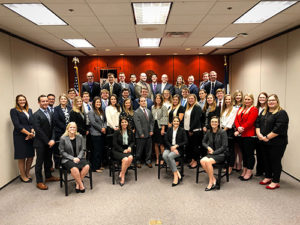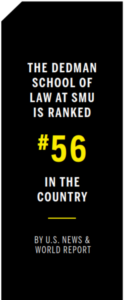UNT Dallas, Texas A&M University Challenge Law School Status Quo
Part of higher education’s purpose is to meet the needs of the surrounding community, whether that be businesses, students, parents or the public at large. In DFW, two universities listened to their communities to create law schools with innovative programs that reflect the communities they serve. The University of North Texas at Dallas College of Law (UNT Dallas) is recognized as the third-most diverse law school in America, with a strong emphasis on client advocacy and legal public service to the surrounding community. Texas A&M University, meanwhile, has grown a school of law providing diverse learning opportunities through cutting-edge clinics and training in intellectual property, energy, health care, and other key areas of study, all while going from unranked, to a top-60 law school in six years.
Why do we need another law school?

In a region that is home to top-tier public institutions and the highly ranked, private Dedman School of Law at SMU, many were skeptical when state Sen. Royce West, former state Rep. Dan Branch, and then UNT System Chancellor Lee Jackson announced the drive to create the UNT Dallas College of Law. The number of law school applications had been declining since 2011 nationally, according to the Law School Admission Council. The number of first-year law students had dropped dramatically, due to rising tuition costs and a perceived lack of legal jobs. Even still, the founders of the UNT Dallas College of Law argued that it was the perfect time to open a new school — one that didn’t replicate what was already being done. The UNT Dallas College of Law trains attorneys who will go back to their communities to provide legal services that many people can’t afford. The cost of law school has contributed to what Texas Supreme Court Chief Justice Nathan Hecht warns is a dangerous, widening justice gap. “See, we’re at a strange place,” Hecht says in a D Magazine article. “We have lots of lawyers looking for jobs, and we have lots of people
who need lawyers. But they can’t get together because of the cost.”
UNT Dallas College of Law believes that it can churn out a new crop of attorneys, less driven by debt, more driven by purpose.
Since its founding in 2014, UNT Dallas College of Law has designed every element of the school — admissions, coursework, experiential learning opportunities and the student population — around its mission to promote justice and to advance human potential through the enterprise of legal education. From the community-centric clinics for students housed in the south and southern Dallas area to meeting future clients in their homes to utilizing virtual reality in order to create crime scenes to learn how to interpret evidence, UNT Dallas College of Law is fulfilling its mission to be a different kind of law school. Named among the 20 Most Innovative Law Schools by PreLaw, a National Jurist publication, UNT Dallas College of Law is living up to the recognition.
New, Ambitious and Entrepreneurial
From the outside, the Texas A&M School of Law looks the same as it did six years ago, when it was Texas Wesleyan Law School: a two-story block of faded brown concrete in downtown Fort Worth. But inside, the school has gone from unranked to one of the top 60 in the country, hiring top new professors, improving job placement numbers and putting itself on par with longstanding law schools in the state.
“Texas A&M is an incredibly ambitious university,” former Interim Dean Thomas Mitchell told the Fort Worth Star-Telegram. “So when they acquired a law school that was unranked, that was not the end goal — just to have a law school. It was to have an outstanding law school.”

Leaders at the Texas A&M School of Law — which was acquired from Texas Wesleyan University in 2013 — aren’t preoccupied with rankings. Instead, they have focused on recruiting a strong and diverse student body and providing their students with the skills necessary to navigate new and established areas of legal practice. From the Entrepreneurship Clinic and the Medical/Legal Partnership with Cook Children’s Hospital, to the Patent Clinic and the Trademark & Copyright Clinic, students serve and engage the community, even as they develop their capacity to succeed as lawyers and leaders. Students can even experience global lawyering, through field study courses in Cambodia, Ghana, Mexico, Scotland and other countries.
In accepting the job of dean of the Texas A&M School of Law, Robert B. Ahdieh said, “I believe no law school in the country has traveled further, in so short a time. Nor does any have more upside potential, going forward.”
Top priorities for the Texas A&M School of Law in the coming years include continuing to build a world-class faculty; ensuring that faculty have the resources necessary to produce research of consequence and significance; extending the audience for a Texas A&M legal education beyond students seeking a three-year Juris Doctor, including through fast-growing non-lawyer programs; and enhancing the scope of the law school’s external engagement through outreach to the community, graduates and colleagues in legal academia.
Combined, the UNT Dallas College of Law and the Texas A&M School of Law are changing the landscape of legal education — not just in the region but at the national level.
This article is part of the 2020 Higher Education Review Magazine.